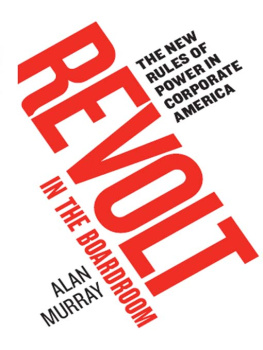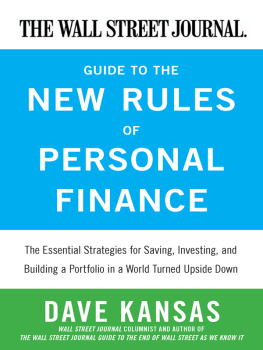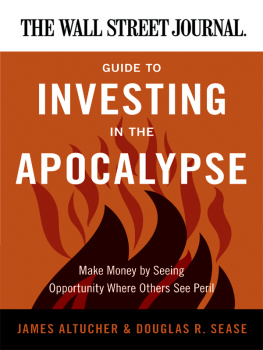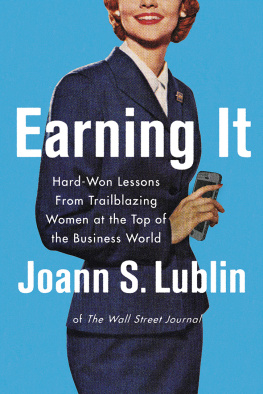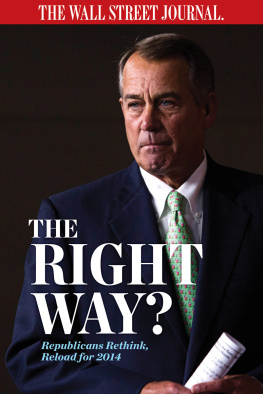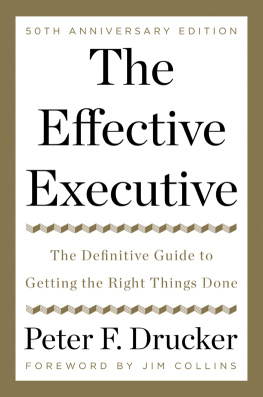Management is not about doing easy things. Management is about doing things that, usually, people dont want to do.
C ARLOS G HOSN , CEO, Nissan Motor Corporation, in a video interview for The Wall Street Journal s Lessons in Leadership series
This book was written during a period of economic disruption, caused by an unprecedented financial crisis that led to the deepest economic downturn since the 1930s. During an extraordinary nine days in September 2008, the U.S. government upended the very foundations of capitalism, nationalizing Fannie Mae and Freddie Mac, arranging a shotgun marriage between Merrill Lynch and Bank of America, allowing the spectacular failure of Lehman Brothers, and then engineering a massive bailout of AIG.
In the aftermath, my neighbors in Greenwich, Connecticut, had the look of lost souls. They had built their spacious mansions and bought their costly foreign cars on the certainty that the global economy would continue to be driven by finance, and finance would continue to be dominated by the United States. As they sifted through the rubble, that certainty disappeared. Both the value of financial innovation and the dominance of American finance came into serious question. The Internet bubble had left behind a legacy of technology after it burst. Aside from Greenwich mansions and Maseratis, it was unclear what legacy the financial bubble might have left. Mortgage-backed securities? Credit default swaps? Who really needed them?
The effects werent limited to finance. Every business, every organization, had to rethink its operations, to reflect what Ian Davis of Mc Kinsey and Company called the new normal. We are experiencing not merely another turn of the business cycle, he wrote, but a restructuring of the economic order. Debt was going to be less plentiful, government was going to be bigger and more intrusive, consumers were going to be more cautious, and business was going to have to adopt a new humility.
Uncertainty was the order of the day. Extrapolations from the pasti.e., residential real estate prices always rise or postwar recessions last six to eight monthswere no longer valid. Nassim Nicholas Talebs book The Black Swan , about powerful events that can neither be predicted nor explained, became the new business bible. The only certainty was that the future would look very different from the past.
It was clear we had reached the end of an era. I had gone to graduate school at the London School of Economics in 1979, just as the old era was beginning. While LSE was still a bastion of left-wing political thought, Margaret Thatcher was setting a new direction for England, extracting government from business and embracing the power of markets. At home, Ronald Reagan took office and pursued a similar course. Privatization and deregulation became the watchwords.
As the Journal s economics correspondent, I had a prime seat to watch the subsequent collapse of communism. I traveled to Poland with a group of cabinet secretaries from the administration of the first President Bush, and met with Leszek Balcerowicz, the man who had been charged with the task of transforming that nations socialist economy into a capitalist one. One of the cabinet secretaries asked Balcerowicz whether he was seeking some sort of third waylike Sweden, perhapsto soften the transition to capitalism. Balcerowicz replied unequivocally. The cold war was over. Communism had lost. Capitalism had won. There was no third way.
At the same time, U.S. business was undergoing a glasnost of its own. In the 1950s and 1960s, analysts like John Kenneth Galbraith had found surprising parallels between Americas large corporations and the Soviet Unions planning agencies. Information rose to the top. Orders flowed down. Hierarchy ruled.
By the late 1970s and 1980s, however, that was all changing. A little book called Up the Organization: How to Stop the Corporation from Stifling People and Strangling Profits became a runaway hit. Its author, former Avis CEO Robert Townsend, called on executives to fire the whole advertising department, fire the whole personnel department, and yes, fire the PR department, too. To get rid of self-perpetuating bureaucracies, he suggested a Vice President in Charge of Killing Things. After the killing was done, he called for a new approach that empowered people, encouraged debate, delegated responsibility, and demanded excellence. Similar ideas rippled through business schools and took root at the best-managed companies.
Parallel revolutions in politics, economic policy, and management led to an extraordinary period of business creativity and prosperity. For the United States and the United Kingdom, which were at the original epicenter, it brought rejuvenation and rebirth. The prophets of decline who stood ready to write the American epitaph in the late 1970s and 1980s were forced to tear up their scripts in the 1990s and acknowledge a continued national vitality they had never imagined. Meanwhile, parts of the developing worldChina and India in particularenjoyed a burst in prosperity and the greatest alleviation of poverty that the world had ever seen.
But the pendulum always swings back. That remarkable heyday of global capitalism had already started to wear out its welcome before the crisis hit. The collapse of the Internet stock bubble, the terror attacks of September 11, and the corporate scandals at Enron, WorldCom, Adelphia, Parmalat, and more, all took their toll. Government began to reassert itself, first in matters of security, then in matters of corporate governance.
Then came September 2008a clean break. History thereafter would be divided into neat partsbefore and after. A new era had begun.
At the Journal , by coincidence, September 16 was the day when we launched a revamped version of our Web site, WSJ.com. The new site not only had an updated look and feel and more multimedia tools, but also, for the first time, allowed readers to comment on our stories. With such big news breaking, traffic to the Web site soared to more than twenty million visitors a month, and comments poured in.
As executive editor of the Web site, I was able to watch as both our reporters and our readers struggled to make sense of the changes buffeting them. As always, the Journal s reporters led the way on many of these developments, with stories like the ones Kate Kelly wrote on the fall of Bear Stearns, or the story that Monica Langley wrote about how mighty Citigroup Inc. had been reduced to pleading with its government overseers on even minute details of its operations. Langley quoted CEO Vikram Pandit begging a senior government official: Dont give up on us.
In November, shortly after the election of Barack Obama, the Journal pulled together roughly a hundred CEOs of the largest companies in the worldpeople like Eric Schmidt of Google, Carlos Ghosn of Nissan, Jeff Bewkes of Time Warner, Jeffrey Kindler of Pfizer, and Angela Braly of WellPoint. As host for the event, I was able to listen in on their private debates as they struggled with some of the biggest issues facing both business and governmentthe future of the economy and the financial system, the challenges of the health care system, the need to move away from dependence on carbon-based fuels. After the meeting, many of the CEOs provided additional counsel as I continued the work on this book.
What struck me about this extraordinary period in our history was the degree to which it validated the need for better management. For some time, management experts had emphasized the creation of organizations that had less hierarchy, were more open and flexible, more democratic, that had distributed decision-making structures, and that were prepared to deal with rapid and unexpected change. These were exactly the characteristics that had allowed the best-managed firms to ride out the crisis, and their absence is what caused others to fail.




